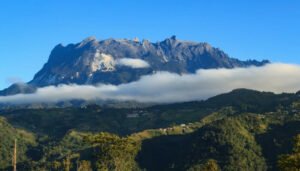Mount Kinabalu, the towering titan of Borneo, doesn’t just stand as a geological marvel. It holds within its rocky embrace a cultural significance that runs deep. For the indigenous people of Sabah, Mount Kinabalu is more than a magnificent peak; it is a sacred entity interwoven into the very fabric of their lives. In this exploration, we delve into the cultural significance of Mount Kinabalu, understanding its profound importance to the local communities, their beliefs, and how this mighty mountain shapes their traditions and spirituality.

Mount Kinabalu in Local Mythology
In the heart of Sabah’s folklore lies the Legend of Aki Nabalu, a creation myth that imbues Mount Kinabalu with mystical origins. It is believed that the mountain was once a stone that gained life, later marrying the spirit of a woman named Mekui. From this union, the Kadazan Dusun people, the indigenous inhabitants of the region, were born. The legend also narrates the tragic tale of the mountain’s subsequent death and how it became the great peak we see today, a story intricately tied to the very essence of the local culture.
Mount Kinabalu: An Ancestral Home and Sacred Ground
Mount Kinabalu is not merely a part of the landscape; it’s an ancestral home and sacred ground for the Kadazan Dusun and Murut communities. It holds a profound spiritual connection, believed to be the resting place of their departed souls.
The Kinabalu Park: A Living Museum of Indigenous Culture
The Kinabalu Park, encompassing Mount Kinabalu, is a living museum that showcases the diverse indigenous cultures of Sabah. It’s a convergence point where the Kadazan Dusun, Murut, Rungus, and other indigenous groups come together to celebrate their traditions, languages, and art forms. The Park acts as a repository of their cultural heritage, preserving age-old practices for future generations.
Mount Kinabalu Festivals
Festivals like the Sabah Fest and the Kaamatan Festival held annually, pay homage to Mount Kinabalu and its cultural significance. These vibrant celebrations bring together various ethnic communities, offering a glimpse into their unique traditions, dances, music, and culinary delights. The festivals amplify the spirit of unity and reinforce the bond that the indigenous people share with Mount Kinabalu.
Climbing Mount Kinabalu
For the Kadazan Dusun, ascending Mount Kinabalu is a profound spiritual journey. It is seen as a passage into the spiritual realm. It is an opportunity to communicate with their ancestors and seek blessings for the community. Each step up the mountain is a step closer to spiritual awakening and self-discovery.
Challenges and Conservation Efforts
In recent years, the increased popularity of trekking Mount Kinabalu has posed challenges to the conservation of its cultural heritage. Issues such as littering, damage to sacred sites, and cultural insensitivity have arisen.
The Sabah Cultural Board and local authorities have collaborated with indigenous communities to implement cultural preservation initiatives. These efforts include the promotion of cultural sensitivity among trekkers, the documentation of oral traditions, and the restoration of sacred sites damaged by natural events.
Cultural Revival and Celebration: Festivals and Heritage Centers
The cultural significance of Mount Kinabalu finds vibrant expression in various festivals and heritage centers. The Kadazan-Dusun Cultural Association organizes events that showcase traditional dances, music, and rituals related to the mountain. These celebrations not only educate visitors but also reinforce the importance of cultural preservation among younger generations.
The Sabah State Museum and Heritage Village, located near Mount Kinabalu, is a repository of indigenous culture and traditions. It houses artifacts, exhibits, and cultural performances that provide visitors with a deeper understanding of the region’s rich heritage, including its connection to the mountain.
Conclusion
Mount Kinabalu stands as a symbol of cultural resilience, spirituality, and harmony with nature. For the indigenous communities of Sabah, it is more than a peak. It is a sacred embodiment of their identity and a living connection to their ancestors. As trekkers ascend the slopes of this magnificent mountain, they have the opportunity to not only witness its natural beauty but also to immerse themselves in the profound cultural significance that has shaped its legacy.
You will find the following information useful :



